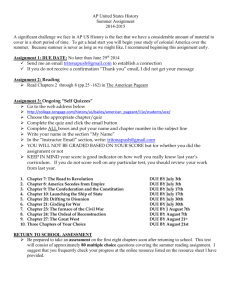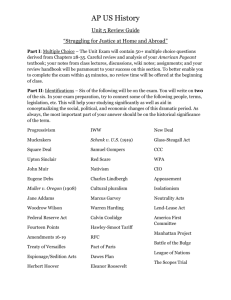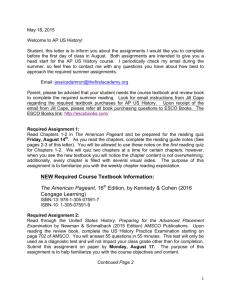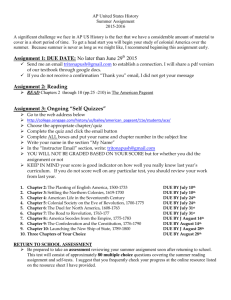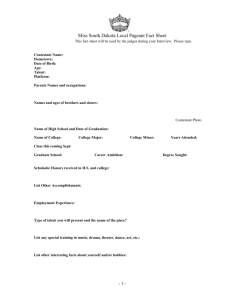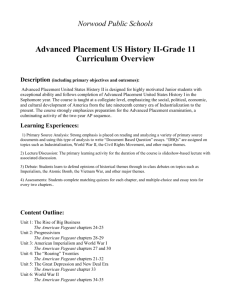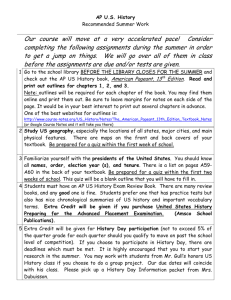Advanced Placement United States History
advertisement
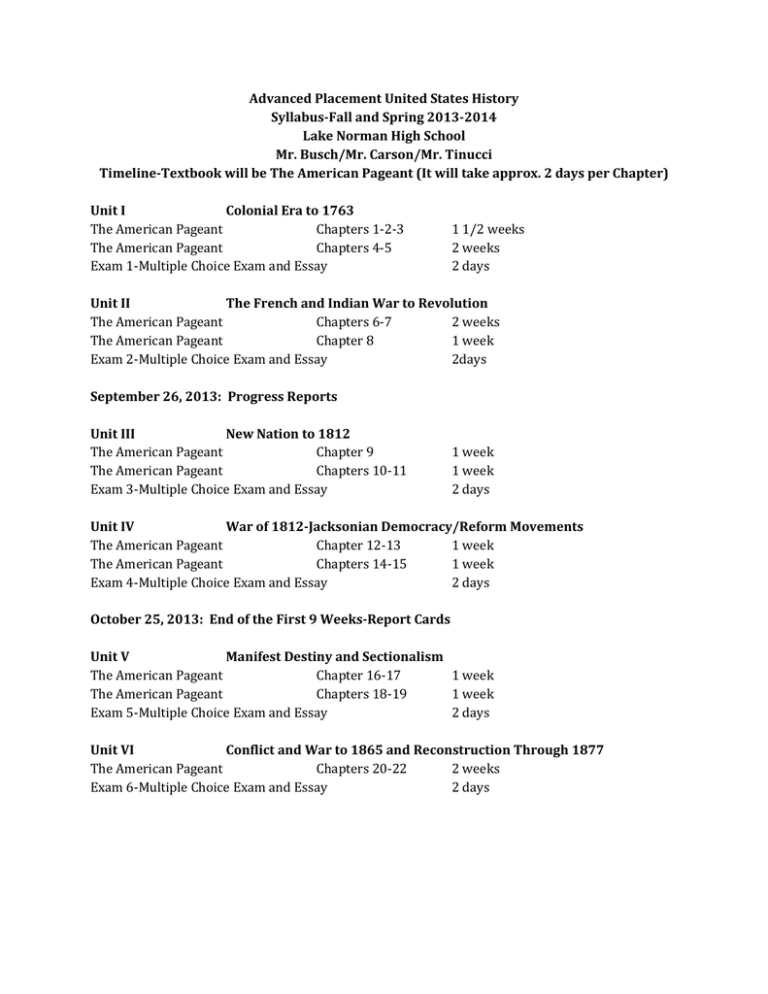
Advanced Placement United States History Syllabus-Fall and Spring 2013-2014 Lake Norman High School Mr. Busch/Mr. Carson/Mr. Tinucci Timeline-Textbook will be The American Pageant (It will take approx. 2 days per Chapter) Unit I Colonial Era to 1763 The American Pageant Chapters 1-2-3 The American Pageant Chapters 4-5 Exam 1-Multiple Choice Exam and Essay 1 1/2 weeks 2 weeks 2 days Unit II The French and Indian War to Revolution The American Pageant Chapters 6-7 2 weeks The American Pageant Chapter 8 1 week Exam 2-Multiple Choice Exam and Essay 2days September 26, 2013: Progress Reports Unit III New Nation to 1812 The American Pageant Chapter 9 The American Pageant Chapters 10-11 Exam 3-Multiple Choice Exam and Essay 1 week 1 week 2 days Unit IV War of 1812-Jacksonian Democracy/Reform Movements The American Pageant Chapter 12-13 1 week The American Pageant Chapters 14-15 1 week Exam 4-Multiple Choice Exam and Essay 2 days October 25, 2013: End of the First 9 Weeks-Report Cards Unit V Manifest Destiny and Sectionalism The American Pageant Chapter 16-17 1 week The American Pageant Chapters 18-19 1 week Exam 5-Multiple Choice Exam and Essay 2 days Unit VI Conflict and War to 1865 and Reconstruction Through 1877 The American Pageant Chapters 20-22 2 weeks Exam 6-Multiple Choice Exam and Essay 2 days Unit VII Gilded Age-Populism-2nd Industrial Revolution-ImmigrationWest The American Pageant Chapter 23-24 1 week The American Pageant Chapters 25-27 2 weeks Exam 7-Multiple Choice and Essay 2 days End of the First Semester and Midterm Exams 1/13-1/17 SECOND SEMESTER-SPRING 2014 Unit VIII American Empire, Progressivism and World War I The American Pageant Chapter 28 1 week The American Pageant Chapters 29-30 1 week Exam 8-Multiple Choice and Essay 2 days Unit IX 1920s and the Great Depression The American Pageant Chapters 31-32 The American Pageant Chapter 33 Exam 9-Multiple Choice and Essay 1 week 1 week 2 days Unit X World War II and The Cold War The American Pageant Chapters 34-35 The American Pageant Chapter 36 Exam 10-Multiple Choice and Essay 1 week 1 week 2 days Spring Break and Progress Reports Unit XI 1950s-1960s The American Pageant Chapter 37 The American Pageant Chapter 38 Exam 11-Multiple Choice and Essay 1 week 1 week 2 days Unit XII 1970s-80s-90s The American Pageant Chapter 39 The American Pageant Chapter 40-41 Exam 11-Multiple Choice and Essay 1 week 1 week 2 days Final Weeks of School AP United States Exam-May 14th Wednesday, 7: 30 am College Planning Student Resumes Interviews AP United States Final Exam-June Information Mr. Richard Tinucci 704-799-8555 (1508) Mr. Mark Carson: (704) 799-8555 (1507) Email rtinucci@iss.k12.nc.us mcarson @iss.k12.nc.us Mr. Jonathan C. Busch: 704-799-8555 (1505) jbusch00@iss.k12.nc.us Cell- 704-652-1836 Objective: To gain a comprehensive understanding of the history of the United States and complete preparation for the Advanced Placement Exam which takes place in May and the Final Exam in June. All course work is divided into twelve units and within each unit the following assignments are required: 1. ****Homework – various assignments such as reading guides, online primary source readings etc… are mandatory, if not turned in on time and complete… there are points taken off your test grade…. Points depend on length and difficulty of assignment…. From 5 to 50 points (out of 400). 2. Multiple Choice Test (Questions are directly from the textbook AND from past AP exams) a. Exam questions are ongoing b. Value-400 points 3. In Class Free Response Essays a. Value- 400 points 4. Quizzes based on the Text a. Value 10-20 points b. 2 per chapter 5. Significant Events and Political Cartoons a. Value-50-100 points What is Required Per Unit? 1. Most units consist of 150 pages of reading from the textbook. We cover a Unit every 2-3 weeks. Students average about 10 pages of reading per night. Primary documents will also be analyzed. There will be a quiz for each reading assignment. 2. An 80 question multiple choice exam will be given each unit. All tests will be comprehensive. 3. Assignments: Terms, Reading Guides, quizzes, classroom analysis work will also be graded. 4. Free Response or Document Based Question will be written for each unit. All writing will be in class and will be timed. 5. Each unit will include 10 significant events or cartoons of the time period-you must have a written paragraph that includes identification, description, point of view and effectiveness 2 pieces of evidence that supports your claim that it is significant. These will NOT be returned to you. ****Opportunities to improve your grade You have several opportunities to improve your grade through extra credit activities. Points will be allotted under the teacher’s discretion. You are encouraged to seek out opportunities from your teacher!!! Class Rules: 1. Be in your seat when class begins. 2. Come prepared to learn and participate 3. Follow directions the first time they are given 4. Do not sleep in class 5. No food, drinks, electronic devices ( unless the device is being used within the framework of the lesson), or other classes’ work during the lesson. These items will be confiscated. 6. Do not cheat. (Cheating, including plagiarism, at any time on any assignment will result in zero credit for the assignment) 7. Do the work! No late or incomplete work will be accepted and will result on points being deducted from the specific unit test grade. The number of points is relative to the assignment and is at the teachers discretion based on the nature of the assignment. 8. There are test corrections but NO Re-Tests in AP US History. 9. Respect everyone Availability for extra help: Mr. Tinucci Tutoring is available every morning when I am not on bus duty. I am also available for tutoring in the afternoon in the Fall and Spring seasons due to coaching Girls Basketball in the Winter. It can be also be set up by an appointment with me. Mr. Carson I am available to tutor students after school from 3:20-4:00. Mr. Busch Tutoring is available in the mornings by appointment and after school until 4:00, however I will have after school duty in the commons… so it will be best to check with me so I can make sure I will be available. Communication with Parents: We are available by a variety of methods (page 3 of this syllabus). We will contact parents or guardians by phone and/or email for negative AND positive work in the classroom. If you have any concerns or questions do not hesitate to contact us at any time . The AP Exam: All students must take the AP US History Exam in May. All students must pay the fee to take the exam. The exam is 3 hours and 5 minutes and consists of two sections: a 55 minute multiple choice section and a 130 minute free response section. There is a mandatory 15 minute reading period. Suggested writing times are 45 minutes for the DBQ-worth 45% of the free response section, 30 minutes for the last two free response questions. Topic Outline 1. Pre-Columbian Societies Early inhabitants of the Americas American Indian empires in Mesoamerica, the Southwest, and the Mississippi Valley American Indian cultures of North America at the time of European contact 2. Transatlantic Encounters and Colonial Beginnings, 1492–1690 First European contacts with American Indians Spain’s empire in North America French colonization of Canada English settlement of New England, the Mid-Atlantic region, and the South From servitude to slavery in the Chesapeake region Religious diversity in the American colonies Resistance to colonial authority: Bacon’s Rebellion, the Glorious Revolution, and the Pueblo Revolt Topics 1-2 include Chapters 1-5 3. Colonial North America, 1690–1754 Population growth and immigration Transatlantic trade and the growth of seaports The eighteenth-century back country Growth of plantation economies and slave societies The Enlightenment and the Great Awakening Colonial governments and imperial policy in British North America 4. The American Revolutionary Era, 1754–1789 The French and Indian War The Imperial Crisis and resistance to Britain The War for Independence State constitutions and the Articles of Confederation The federal Constitution Topics 3-4 include Chapters 6-8 5. The Early Republic, 1789–1815 Washington, Hamilton, and shaping of the national government Emergence of political parties: Federalists and Republicans Republican Motherhood and education for women Beginnings of the Second Great Awakening Significance of Jefferson’s presidency Expansion into the trans-Appalachian West; American Indian resistance Growth of slavery and free Black communities The War of 1812 and its consequences 6. Transformation of the Economy and Society in Antebellum America The transportation revolution and creation of a national market economy Beginnings of industrialization and changes in social and class structures Immigration and nativist reaction Planters, yeoman farmers, and slaves in the cotton South Topics 5-6 Include Chapters 9-11 7. The Transformation of Politics in Antebellum America Emergence of the second party system Federal authority and its opponents: judicial federalism, the Bank War, tariff controversy, and states’ rights debates Jacksonian democracy and its successes and limitations 8. Religion, Reform, and Renaissance in Antebellum America Evangelical Protestant revivalism Social reforms Ideals of domesticity Transcendentalism and utopian communities American Renaissance: literary and artistic expressions Topic 7-8 Include Chapters 12-15 9. Territorial Expansion and Manifest Destiny Forced removal of American Indians to the trans-Mississippi West Western migration and cultural interactions Territorial acquisitions Early U .S . imperialism: the Mexican War 10. The Crisis of the Union Pro- and antislavery arguments and conflicts Compromise of 1850 and popular sovereignty The Kansas–Nebraska Act and the emergence of the Republican Party Abraham Lincoln, the election of 1860, and secession Topics 9-10 Include Chapters 16-19 11. Civil War Two societies at war: mobilization, resources, and internal dissent Military strategies and foreign diplomacy Emancipation and the role of African Americans in the war Social, political, and economic effects of war in the North, South, and West 12. Reconstruction Presidential and Radical Reconstruction Southern state governments: aspirations, achievements, failures Role of African Americans in politics, education, and the economy Compromise of 1877 Impact of Reconstruction Topics 11-12 Include Chapters 20-22 13. The Origins of the New South Reconfiguration of southern agriculture: sharecropping and crop-lien system Expansion of manufacturing and industrialization The politics of segregation: Jim Crow and disfranchisement 14. Development of the West in the Late Nineteenth Century Expansion and development of western railroads Competitors for the West: miners, ranchers, homesteaders, and American Indians Government policy toward American Indians Gender, race, and ethnicity in the far West Environmental impacts of western settlement 15. Industrial America in the Late Nineteenth Century Corporate consolidation of industry Effects of technological development on the worker and workplace Labor and unions National politics and influence of corporate power Migration and immigration: the changing face of the nation Proponents and opponents of the new order, e .g ., Social Darwinism and Social Gospel Topics 13-15 Include Chapters 23-27 16. Urban Society in the Late Nineteenth Century Urbanization and the lure of the city City problems and machine politics Intellectual and cultural movements and popular entertainment 17. Populism and Progressivism Agrarian discontent and political issues of the late nineteenth century Origins of Progressive reform: municipal, state, and national Roosevelt, Taft, and Wilson as Progressive presidents Women’s roles: family, workplace, education, politics, and reform Black America: urban migration and civil rights initiatives 18. The Emergence of America as a World Power American imperialism: political and economic expansion War in Europe and American neutrality The First World War at home and abroad Treaty of Versailles Society and economy in the postwar years Topics 16-18 Include Chapters 28-30 19. The New Era: 1920s The business of America and the consumer economy Republican politics: Harding, Coolidge, and Hoover The culture of Modernism: science, the arts, and entertainment Responses to Modernism: religious fundamentalism, nativism, and Prohibition The ongoing struggle for equality: African Americans and women 20. The Great Depression and the New Deal Causes of the Great Depression The Hoover administration’s response Franklin Delano Roosevelt and the New Deal Labor and union recognition The New Deal coalition and its critics from the Right and the Left Surviving hard times: American society during the Great Depression Topics 19-20 Include Chapters 31-33 21. The Second World War The rise of fascism and militarism in Japan, Italy, and Germany Prelude to war: policy of neutrality The attack on Pearl Harbor and United States declaration of war Fighting a multifront war Diplomacy, war aims, and wartime conferences The United States as a global power in the Atomic Age 22. The Home Front During the War Wartime mobilization of the economy Urban migration and demographic changes Women, work, and family during the war Civil liberties and civil rights during wartime War and regional development Expansion of government power 23. The United States and the Early Cold War Origins of the Cold War Truman and containment The Cold War in Asia: China, Korea, Vietnam, and Japan Diplomatic strategies and policies of the Eisenhower and Kennedy administrations The Red Scare and McCarthyism Impact of the Cold War on American society Topics 21-23 Include Chapters 34-36 24. The 1950s Emergence of the modern civil rights movement The affluent society and “the other America” Consensus and conformity: suburbia and middle-class America Social critics, nonconformists, and cultural rebels Impact of changes in science, technology, and medicine 25. The Turbulent 1960s From the New Frontier to the Great Society Expanding movements for civil rights Cold War confrontations: Asia, Latin America, and Europe Beginning of Détente The antiwar movement and the counterculture Topics 24-25 Include Chapters 37-38 26. Politics and Economics at the End of the Twentieth Century The election of 1968 and the “Silent Majority” Nixon’s challenges: Vietnam, China, and Watergate Changes in the American economy: the energy crisis, deindustrialization, and the service economy The New Right and the Reagan revolution End of the Cold War 27. Society and Culture at the End of the Twentieth Century Demographic changes: surge of immigration after 1965, Sunbelt migration, and the graying of America Revolutions in biotechnology, mass communication, and computers Politics in a multicultural society 28. The United States in the Post–Cold War World Globalization and the American economy Unilateralism vs . multilateralism in foreign policy Domestic and foreign terrorism Environmental issues in a global context Topics 26-28 Include Chapters 39-42

